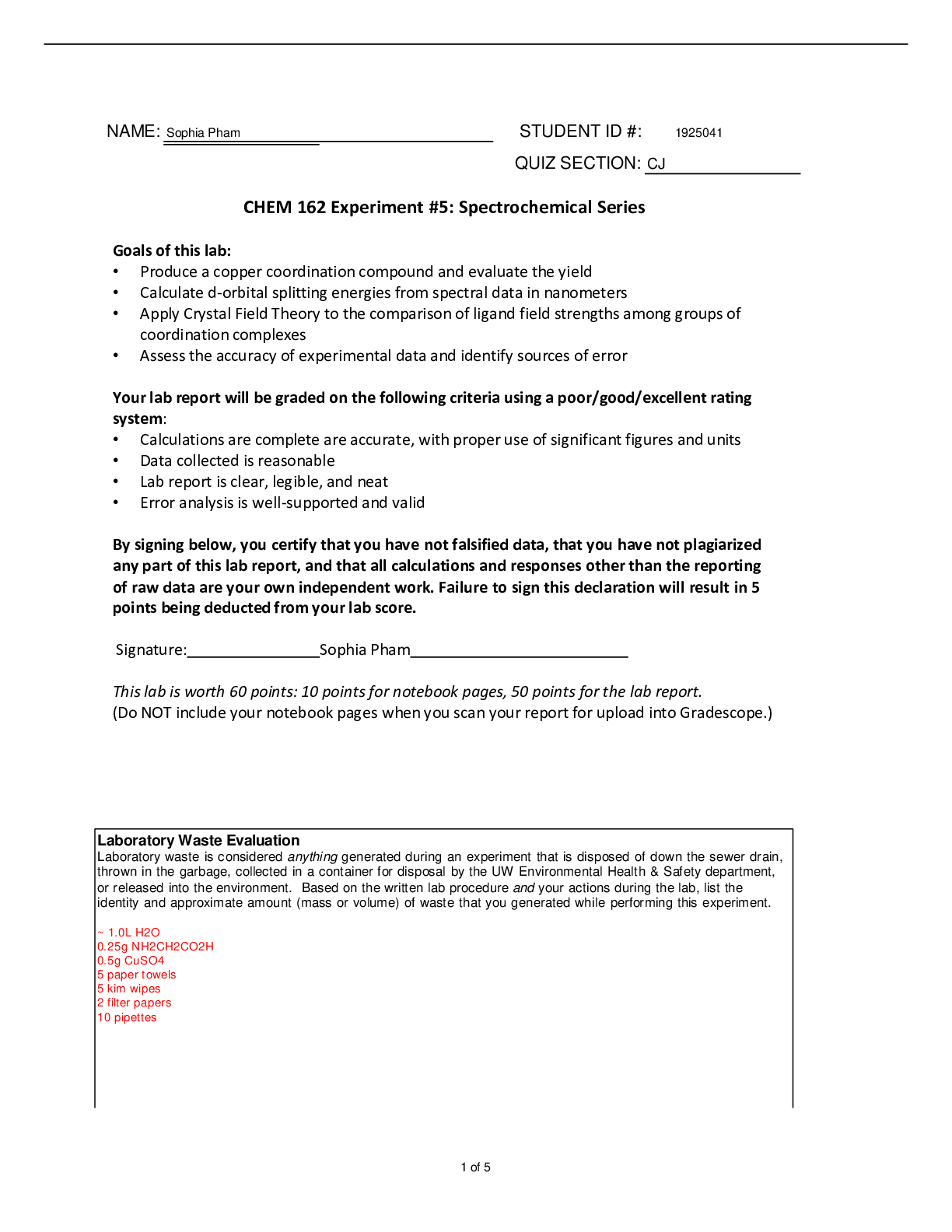Chemistry > Lab Report > University of California, Berkeley - CHEMISTRY X19Specific+Heat+Capacity+Simulation (All)
University of California, Berkeley - CHEMISTRY X19Specific+Heat+Capacity+Simulation
Document Content and Description Below
Specific Heat Capacity Simulation Heat is a form of energy, often called thermal energy. Energy can be transformed from one form to another (electric energy to heat and light in a light bulb, for ex... ample), but it cannot be created or destroyed; rather, energy is conserved. The higher the temperature of a material, the more thermal energy it possesses. In addition, at a given temperature, the more of a given substance there is, the more total thermal energy the material possesses. On an atomic level, absorbed heat causes the atoms of a solid to vibrate, much as if they were bonded to one another through springs. As the temperature is raised, the energy of the vibrations increases. In a metal, this is the only motion possible. In a liquid or gas, absorbed heat causes the atoms in the molecule to vibrate, and the molecule to both rotate and move from place to place. Because there are more “storage” possibilities for energy in liquids and gases, their heat capacities are larger than in metals. Molar heat capacity, cm, is the amount of heat required to change the heat content of 1 mole of a material by exactly 1°C. Specific heat, csp, is the amount of heat required to change the heat content of exactly 1 gram of a material by exactly 1°C. Specific heat values can be determined in the following way: When two materials, each initially at a different temperature, are placed in contact with one another, heat always flows from the warmer material into the colder material until the two materials are at the same temperature. From the law of conservation of energy, the heat gained by the initially colder material must equal the heat lost by the initially warmer material: (heat lost) hot object = (heat gained) cold object (1) Since heat lost is a negative term, and heat gained is a positive term, the equation can be written: -q hot = q cold (2) where q is used as the abbreviation for heat. The heat quantities in this equation would be calculated as (specific heat) x (mass of the object) x (the temperature change of the object), because specific heat has units of energy per (mass x degrees). Equation 2 then becomes: -(csp·m·∆T) hot = (csp·m·∆T)cold (3) In today’s experiment, you will place hot metal into cold water, but we need to consider how much heat is absorbed by the calorimeter. The water will be in a Styrofoam cup with a temperature probe in it. The cup and the temperature probe will also absorb some heat. If the heat that the cup and thermometer absorb per degree is labeled Ccup, then equation (3) becomes: -(csp·m·∆T)hot = (csp·m·∆T)cold + Ccup·∆Tcold (4) Basic idea of how coffee cup experiments are run: https://www.youtube.com/watch?v=NZuU8BGj3uY OBJECTIVES In this experiment, you will • Determine the Heat Capacity of a calorimeter, Ccup, mixing hot and cold water. • Determine the Specific Heat Capacity, csp, of an unknown metal. • Determine the Heat of Dissolution • Determine the Heat of a Reaction [Show More]
Last updated: 2 years ago
Preview 1 out of 4 pages

Buy this document to get the full access instantly
Instant Download Access after purchase
Buy NowInstant download
We Accept:

Reviews( 0 )
$5.00
Can't find what you want? Try our AI powered Search
Document information
Connected school, study & course
About the document
Uploaded On
Apr 15, 2021
Number of pages
4
Written in
Additional information
This document has been written for:
Uploaded
Apr 15, 2021
Downloads
0
Views
53




.png)









